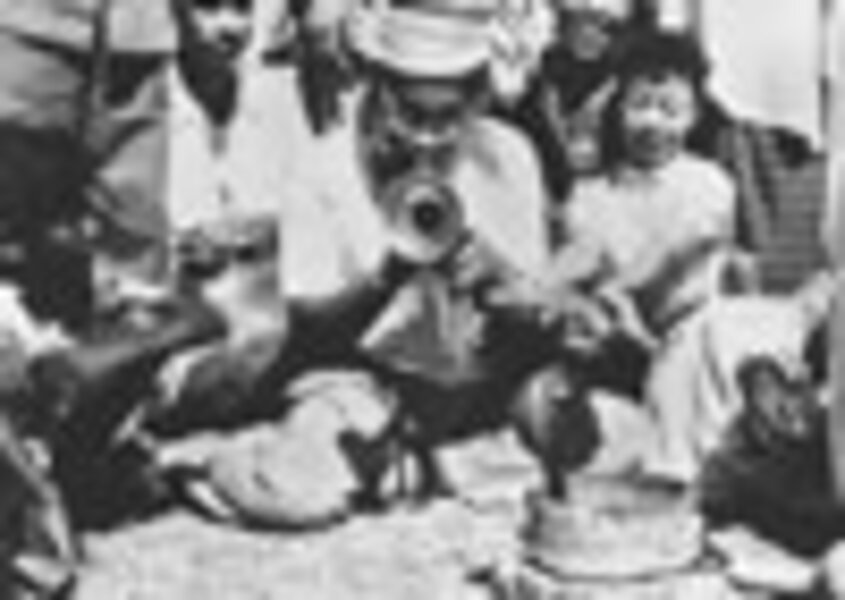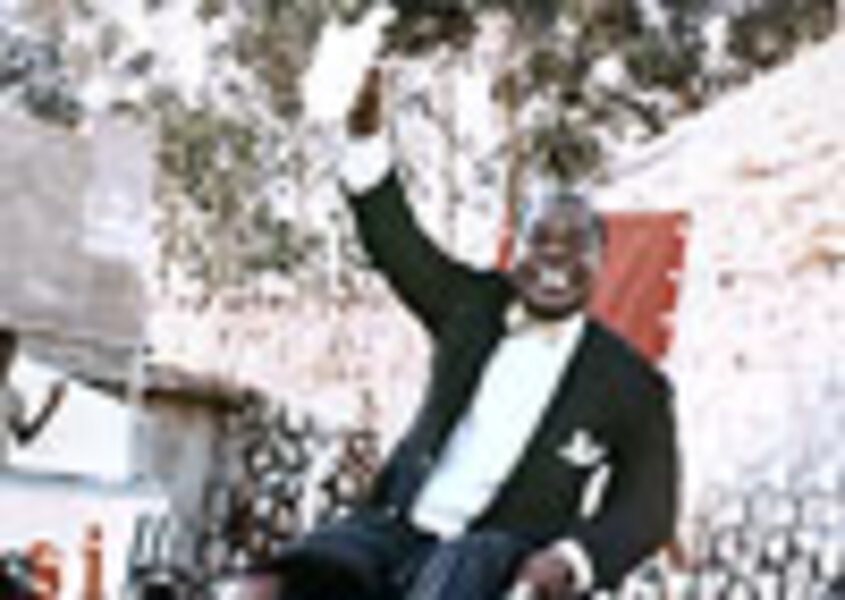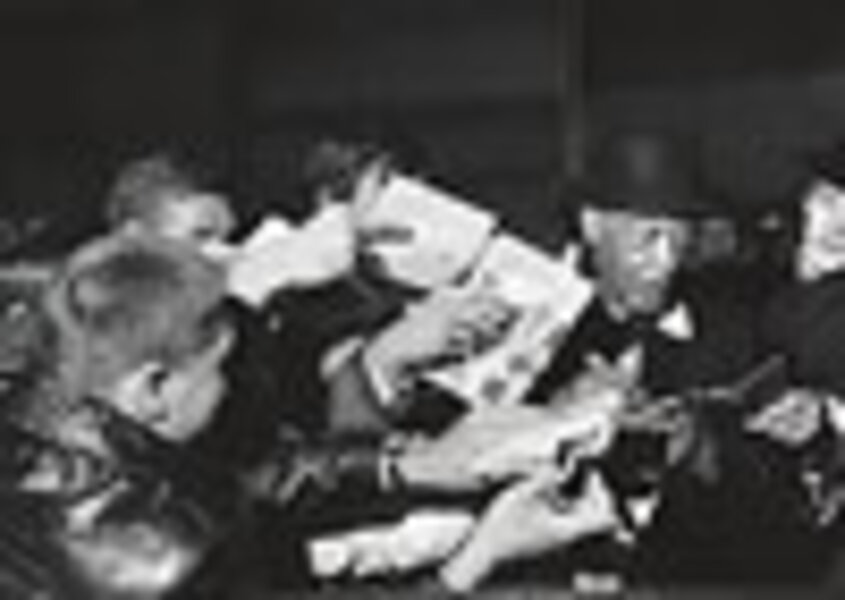Photo exhibit offers an intimate look at America's jazz ambassadors
Loading...
The black-and-white photographs in "Jam Session: America's Jazz Ambassadors Embrace the World" don't come with a manual, but they should.
The 70-odd images about to go on display at the Louisiana State Museum in New Orleans will tour the country before going abroad like the musicians who spiffed up America's image during the cold war.
Three months after Rosa Parks refused to move to the back of a Montgomery, Ala., bus and roughly at the same time that black Americans were facing censure and arrest as a matter of law and whim, the US Department of State entrusted jazz musicians with representing America to the world.
Today, jazz is considered high art. In 1956, however, when Dizzy Gillespie became the first to tour under the Jazz Ambassadors program, jazz musicians were distinctively lowbrow; they had the same chance of winning presidential honors as a rap group does today. Jazz, after all, was Negro music, burped, fed and nurtured in all-Negro communities.
Browsing 20 years of happy images of black musicians performing on State Department-sponsored tours inspires a kind of cognitive dissonance. White Americans are reacting violently to Supreme Court orders to desegregate public schools, but here is a photo of Gillespie in 1956, sitting cross-legged on the ground, charming a cobra with either his cheeks or his trumpet in Karachi, Pakistan.
Lunch counter sit-ins, kicked off by four Greensboro, N.C., students, have spread like wildfire throughout the South, but here is another photo of Louis Armstrong in 1960, smiling, of course, hoisted like some gleeful maharajah on the shoulders of adoring fans in independent Congo.
What was it like for these black musicians to headline celebratory concerts for newly decolonized African nations on the one hand, but still not be able to stay in hotels south of the Mason-Dixon line back home? What was it like to travel under the auspices of a country known abroad for, as saxophonist Paul Jeffrey was told in Italy, white men being the boss of black men?
The questions provoked by this exhibit have the wonderful effect of humanizing the real-life men and women still breathing despite their poster-sized reincarnations as dead musicians on a wall.
"If you ask a black jazz musician to be a diplomat for a country that is still segregated," says Richard Pells, professor of history at the University of Texas at Austin and expert on post-World War II American cultural exports, "you put him in a very difficult position overseas."
The most famous grumble of discontent remains Armstrong's 1957 rebuke of President Dwight Eisenhower's foot-dragging on school desegregation in Little Rock, Ark. "The way they are treating my people in the South," Armstrong had said, while canceling plans for a State Department-sponsored Soviet tour, "the government can go to hell."
More often than not, though, musicians' rebellions were not publicly captured.
Mr. Jeffrey, who often toured with Thelonious Monk, founded Duke University's jazz program more than 20 years ago. He still lives in North Carolina and remembers touring Europe with Gillespie shortly after runners John Carlos and Tommie Williams raised black-gloved fists in protest at the 1968 Summer Olympics in Mexico City.
During one of his sets, drummer Max Roach, who also headlined, wore a black glove to show solidarity. It was an undiplomatic overture that did not sit well with State Department etiquette.
But Jeffrey agreed with Roach's political play. "To be used as a pawn to signify that everything's OK when it's not, kinda leaves one...," Jeffrey says, before trailing off into a memory of segregated facilities and verbal insults he suffered while playing the Deep South in the early 1960s with B.B. King.
"America exporting its contradictions," is how author Penny von Eschen, in "Satchmo Blows Up the World: Jazz Ambassadors Play the Cold War," describes the State Department's strategy of sending integrated jazz bands abroad to counter foreign perceptions of US racism at home.
The ultimate aim, of course, was to best the Soviet Union, which exported cultural ambassadors almost as often as it increased its nuclear stockpiles.
And although it is fair to assume that a bit of music never hurt, how much a musician's charm and soul helped to win the cold war, or the newly rebranded global war on terror, is almost impossible to objectively measure, Professor Pells says.
One rare attempt was a May 2006 evaluation of the jazz abroad program, renamed the Rhythm Road – the first comprehensive survey of any cultural program at the State Department.
Among worldwide embassy staff who responded, 97 percent agreed that overall, jazz performances and workshops allowed for dialogue to continue, even when foreign audiences disagreed with US policy.
"When things get really tough, you don't like American cultural influence because you blame them for what is happening," Iraqi journalist Ali Adeeb says, referring to 2006-07 when civilian deaths spiked in Iraq. But in a welcome sign of relative normalcy this past April, an American jazz band played an open-air concert in Baghdad.
Iraqis, especially young people, are becoming more interested in Western culture, Mr. Adeeb says. "Go to YouTube and you find rap songs with Iraqi slang words talking about the explosions and what is going on," he says, describing American soldiers blasting rap at checkpoints in Baghdad neighborhoods. "Young people use the music to talk to the American soldiers."
"Break dancing and hip-hop are the jazz of the new millennium," pianist John Ferguson, founder of American Voices, a Houston-based music diplomacy nonprofit, writes in an e-mail from Beirut. In 2004, Ferguson incorporated a Hiplomacy tour after seeing how break-dancers and a DJ drew the under-30 crowd to a jazz festival he organized in Baku, Azerbaijan.
This year, he says, State Department budget cuts forced him to cancel two hip-hop tours to Serbia and Lithuania.
"When the US sends jazz musicians overseas, it's not the same as sending an opera singer," says Nicholas Cull, professor of public diplomacy at the University of Southern California's Annenberg School for Communication, who points out that jazz's interactive and improvisational nature makes fast friends.
Professor Cull hopes that President Obama will match rising interest shown by emergent powers China and Russia in sending their artists abroad.
Back in the 1960s, when pianist Randy Weston toured Africa with the State Department, the 6-foot-7 Brooklynite often went looking for the oldest man in the oldest village with the oldest instrument so that he could hear the most traditional music.
"Those tours gave me an opportunity to go back to the motherland," Mr. Weston says. His father followed Marcus Garvey, whom the US government jailed and deported in the 1920s, ostensibly for his radical "back to Africa" politics. Talk about living the contradiction that was America.
Jeffrey, now retired, fell in love with Italy. He established annual exchanges with Italian musicians as part of his jazz program at Duke.
"Whatever you do," he says "you should be trying to do something positive even if it's under the worst conditions."
With Mr. Obama as president, Jeffrey says with a chuckle, "When you go over there now, you're not living so much of a lie."
•Tour dates for Jam Session: July 17–Sept. 20, 2009: Louisiana State Museum, New Orleans; Oct. 19, 2009–Feb. 19, 2010: The American Jazz Museum, Kansas City, Mo.; March 8–April 30, 2010: Montana Museum of Art & Culture, University of Montana, Missoula.








